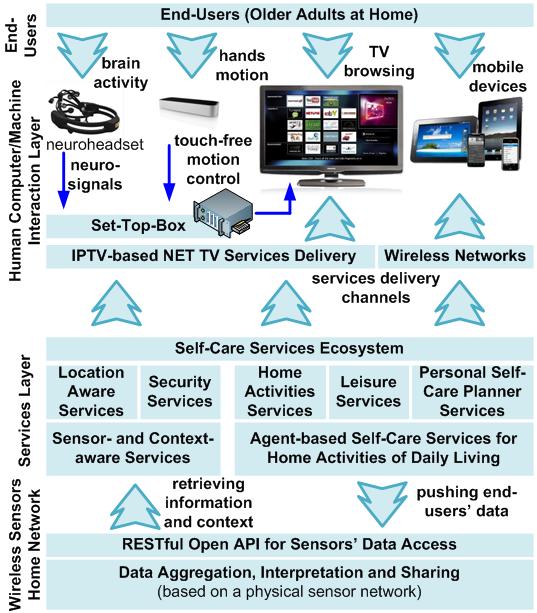ubi:aalservices increasing the autonomy, self-confidence and mobility of elderly individuals
The elderly individuals constitute a critical mass of the European population. Eurostat’s latest population projections were completed covering the period from 2011 to 2060 – and show that population ageing is likely to affect all EU Member States over this period. It shows that the EU’s population will be slightly higher in 2060, while the age structure of the population will be much older than it is now. Older persons will likely account for an increasing share of the total population – those aged 65 years or over will account for 29.5 % of the EU-27’s population by 2060 (17.4 % in 2010), while the share of those aged 80 years or above in the EU-27’s population is projected to almost triple between 2010 and 2060. Yet, this critical mass of elderly individuals is a mass not with disabilities to be treated as societal outcasts, but as individuals with identified needs, which can – given the appropriate resources and aid – play an active and important role towards the societal and economic benefit of the European communities.
ubi:aalservices aims to extend the time people can live in their preferred environment by increasing their autonomy, self-confidence and mobility; to support elderly individuals in maintaining health and functional capability, to promote a better and healthier lifestyle for individuals at risk; to enhance the security, to prevent social isolation and to support maintaining the multifunctional network around the individual. ubi:aalservices provide customizable services to elderly individuals tailored to their needs, while at the same time adopt, and utilise advanced Human-Machine Interfaces, through which innovative bouquets of services are delivered, deployed taking into consideration the needs and particularities of elderly individuals, including hardware components that capture human physical and brain activities and touch-free motion sensing and control modalities, as well as smart-phones and interactive TVs. ubi:aalservices comprise a cross-platform, viable, extensible and sustainable ecosystem of services targeted towards the needs of elderly individuals, which facilitates the provision of services in an integrated, intuitive way, customized specifically for the needs of elderly individuals, on top of a scalable wireless sensors infrastructure though two main delivery channels, i.e. a) an IPTV-based one that allows end-users to access services through the typical TV browsing, and b) a set of cross-platform mobile applications that allows user to access services anywhere, anytime utilizing their mobile devices (e.g. smart phones and tablets). The platform is leveraged by the integration of innovative human computer interaction modalities and foresees to benefit from the developments, progress and current advancements in the field, such as the touch-free hands motion and the brain activity.

The platform allows for the deployment of a Wireless Sensors Home Network integrating a set of sensor nodes (without any configuration effort, allowing nodes to freely enter and leave the existing network) and incorporating a large number of different sensors and communication modules (including but not limited to temperature, humidity, illumination, acceleration, movement, gate status and heart rate). On top of this physical sensor network, a data fusion, interpretation and sharing layer collects and integrates sensor data and provides other layers with a RESTful open API, allowing service modules to access sensors data and set triggers and alerts, retrieving information and context from the installed sensors network.
Based on this Wireless Sensor Home Network (WSHN), a self-care services ecosystem is built, realizing sensor-intensive, context-aware services, e.g. Location Awareness Services, Safety Services and more. Extracting context and accepting triggers and alerts from the static nodes installed in the older person’s home environment, facilitates the creation of an accurate indoor track and trace mechanism for objects and people. Moreover, the integration of acceleration, illumination and other sensors in the deployed WSHN enables the implementation of a home safeguard mechanism and a fall detection utility, which can be also supported by the accelerometer assembled in the older person’s smartphone, that can also be utilized for the realization of ubiquitous emergency services. In addition to these context-aware services, more bouquets of self-care services can be developed and integrated in the services ecosystem. More specifically, a bouquet of personal self-care planner services can be delivered to the elderly individuals and their (in)formal carers, incorporating medication reminders and watchdog mechanisms that ensure mainly medication intake compliance, physical and cognitive training utilities that assist the older person at his/her daily workout, and nutrition watchdog mechanism for remotely ordering food and beverages required for his/her daily diet. Additionally, leisure services can be delivered to the elderly individuals, including news aggregation services and intelligent calendars for daily activity planning and activities sharing with family, friends, neighbors and (in)formal carers.
The self-management care services of the platform can be delivered to the end-users (both older persons and carers) though two main delivery channels. The first one adopts IPTV-based platforms delivering services directly in the older person’s home environment as long as he/she owns a TV-set with direct IP connectivity and Internet access. Apart from the traditional “remote control” of the television that allows the elderly individuals to access and interact with the services provided, ubi:aalservices incorporate additional human computer interaction modalities, integrating state-of-the-art hardware components that capture human physical and brain activities – interconnecting them with the TV set through low-cost set-top-boxes, along with HCI modalities that allow the touch-free motion sensing and control. The second delivery channel is based on the provision of services at the older persons’ mobile-/smart- phones though the existing mobile, telecom and wireless networks. Mobile versions of the self-care services, based on a cross-platform native mobile applications development framework can also be delivered, facilitating the development of mobile applications and their deployment on several mobile operating systems (including Android, Windows Mobile and iOS).



